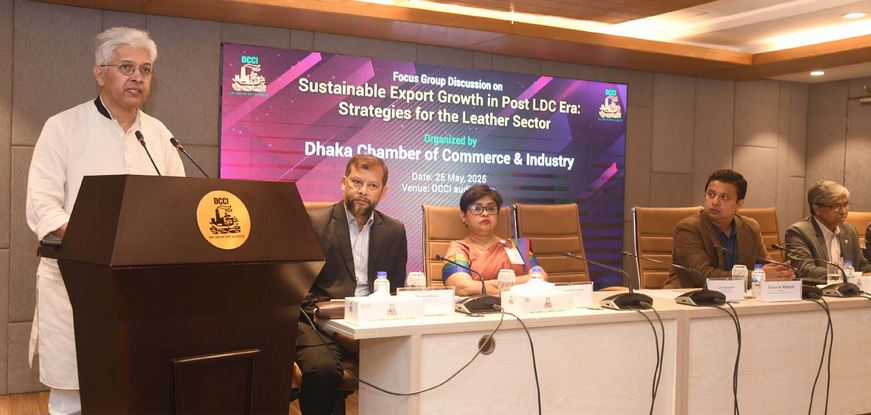News Flash

DHAKA, May 25, 2025 (BSS) - Speakers at a seminar today put emphasis on creating an integrated roadmap to turn the leather sector as the next pillar of export growth.
They also underscored the need for ensuring compliance and international certification to tap the potentials in the export growth of leather goods.
They made such observations at a seminar on "Sustainable Export Growth in Post LDC Era: Strategies for the Leather Sector" held today at the Dhaka Chamber of Commerce and Industry (DCCI) in the capital.
Speaking at the seminar as the chief guest, Industries Adviser Adilur Rahman Khan said international certification is crucial for the competitiveness of the leather sector as the buyers offer lower price to the exporters lacking environmental certification.
"At present we've only three Leather Working Group (LWG) certified tanneries in Bangladesh. Recognizing these realities, the Ministry of Industries is working to create a supportive policy environment that can enable long-term transformation," he said.
He remarked that Bangladesh's leather industry must move beyond competing on price to capture a larger share of the US$420 billion global leather goods market.
Regarding capacity building of CETP at Savar Tannery Park, Adilur requested the tannery owners to establish ETP of their own since the government is currently allowing it.
He said the government would play a catalytic role by creating a broad ecosystem along with the industry players, private investors and development partners.
The Industries Adviser also urged the tannery owners to be more careful about the climate, environment and rivers as because at the end of the day all would have to save the environment.
Md. Hafizur Rahman, Administrator of FBCCI, said that inbound foreign investment in the leather sector is low due to lack of LWG certification while on the other side entrepreneurs are being deprived of getting good prices for their products.
He also expressed his thoughts in favour of the Central Effluent Treatment Plant (CETP), because it is easy to operate as well as bearing the cost of CETP collectively while it is also easy to monitor single.
"If the industry players can maintain the environmental, social, and governance (ESG) compliance, it will be easier to get LWG certificates and it will help attract Foreign Direct Investment (FDI), because we've a lot of low cost raw materials here," he added.
The FBCCI Administrator said Bangladesh's leather sector and other promising export-oriented sectors should get the same treatment as the Ready-Made Garments (RMG) is having now.
He also hoped that in the next budget, the government would allow all to have the bonded warehouse facility.
Md. Saiful Islam, chairman of Bangladesh Small and Cottage Industries Corporation (BSCIC), said the issue of CETP is the most important in the leather sector.
He said the capacity of the CETP installed at Savar is currently 14,000 cubic meters while the demand during the peak season is 32,000 to 35,000 cubic meters.
"A technical team is working to increase the capacity of the CETP, so it can be increased up to 20,000 to 25,000 cubic meters," he added.
He said initially six institutions have been given permission to establish ETP of their own, while another eight to 10 tanneries are in the process of getting approval.
Saiful also urged the entrepreneurs to adhere to compliance to prevent environmental pollution.
Since the country lacks LWG certified tanneries, he therefore emphasized exploring new export destinations, product innovation and use of modern technology in the leather sector.
DCCI President Taskeen Ahmed said the leather sector, the second-highest export earner after RMG, has potential for value addition, employment generation and sustainable industrial growth particularly in the post-LDC era when preferential trade benefits may gradually phase out.
To ensure a sustainable export growth in post-LDC era, he recommended for green transformation of tanneries, skills development, improved value chain, strong backward linkage, exploring new export destinations and public-private collaboration with a view to make this sector a pillar of the country's sustainable export item.
While presenting the keynote paper, Syed Nasim Manzur, managing director (MD) of Apex Footwear Ltd, said it has been many years since the tanneries have been shifted from Hazaribagh to Savar, but the CETP is yet to be operationalised fully which is also hampering the export growth. He showed that the leather industry's annual exports are hovering around
US$1.2 billion to $1.6 billion, but with incentives and policy support like the readymade garment sector avails, it will be able to export $5 billion annually by 2030 and thus increase it to $10 billion by 2035.
Nasim also urged the government to help small entrepreneurs of the leather sector so that they can avail low cost financial assistance from the Climate Finance Fund.
Dr. Nazneen Kawshar Chowdhury, additional secretary of WTO Wing, Ministry of Commerce, Md. Ariful Hoque, director general (Joint Secretary) of Strategic Investment (Additional Charge), Bangladesh Investment Development Authority (BIDA), Dr. Mohammed Mizanur Rahman, Professor of Department of Applied Chemistry & Chemical Engineering, University of Dhaka, Salma Ahmed, chief scientific officer (Officer-in-Charge) of Leather Research Institute, Bangladesh Council of Scientific and Industrial Research (BCSIR), Ziaur Rahman, Bay Group MD, Md. Nasir Khan, MD of Jennys Shoes Ltd., Ibnul Wara, MD of Austan Ltd., Md. Nurul Islam, chief executive officer of Bangladesh Tanners Association (BTA) and M. Abu Hurairah spoke, among others, at the seminar.
DCCI Senior Vice-President Razeev H Chowdhury and Vice President Md. Salem
Sulaiman were present, among others.